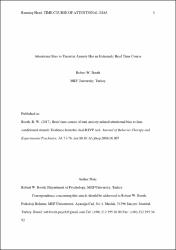Please use this identifier to cite or link to this item:
https://hdl.handle.net/20.500.11779/122Full metadata record
| DC Field | Value | Language |
|---|---|---|
| dc.contributor.author | Booth, Robert William | - |
| dc.date.accessioned | 2016-07-22T09:31:23Z | |
| dc.date.available | 2016-07-22T09:31:23Z | |
| dc.date.issued | 2016 | - |
| dc.identifier.citation | Booth, R. W. (2017). Brief time course of trait anxiety-related attentional bias to fear-conditioned stimuli: Evidence from the dual-RSVP task. Journal of Behavior Therapy and Experimental Psychiatry, 54, 71-76. http://dx.doi:10.1016/j.jbtep.2016.06.007 | en_US |
| dc.identifier.issn | 0005-7916 | - |
| dc.identifier.issn | 1873-7943 | - |
| dc.identifier.uri | http://dx.doi.org/10.1016/j.jbtep.2016.06.007 | - |
| dc.identifier.uri | https://hdl.handle.net/20.500.11779/122 | - |
| dc.description | Yazar tarafından 48 ay ambargo konmuştur. | en_US |
| dc.description.abstract | Background and objectives Attentional bias to threat is a much-studied feature of anxiety; it is typically assessed using response time (RT) tasks such as the dot probe. Findings regarding the time course of attentional bias have been inconsistent, possibly because RT tasks are sensitive to processes downstream of attention. Methods Attentional bias was assessed using an accuracy-based task in which participants detected a single digit in two simultaneous rapid serial visual presentation (RSVP) streams of letters. Before the target, two coloured shapes were presented simultaneously, one in each RSVP stream; one shape had previously been associated with threat through Pavlovian fear conditioning. Attentional bias was indicated wherever participants identified targets in the threat’s RSVP stream more accurately than targets in the other RSVP stream. Results In 87 unselected undergraduates, trait anxiety only predicted attentional bias when the target was presented immediately following the shapes, i.e. 160 ms later; by 320 ms the bias had disappeared. This suggests attentional bias in anxiety can be extremely brief and transitory. Limitations This initial study utilised an analogue sample, and was unable to physiologically verify the efficacy of the conditioning. The next steps will be to verify these results in a sample of diagnosed anxious patients, and to use alternative threat stimuli. Conclusions The results of studies using response time to assess the time course of attentional bias may partially reflect later processes such as decision making and response preparation. This may limit the efficacy of therapies aiming to retrain attentional biases using response time tasks. | en_US |
| dc.language.iso | en | en_US |
| dc.publisher | Elsevier | en_US |
| dc.relation.ispartof | Journal of Behavior Therapy and Experimental Psychiatry | en_US |
| dc.rights | info:eu-repo/semantics/openAccess | en_US |
| dc.subject | Attentional bias | en_US |
| dc.subject | Anxiety | en_US |
| dc.subject | Rt vs. accuracy | en_US |
| dc.subject | Time course | en_US |
| dc.title | Brief Time Course of Trait Anxiety-Related Attentional Bias To Fearconditioned Stimuli: Evidence From the Dual-Rsvp Task | en_US |
| dc.type | Article | en_US |
| dc.identifier.doi | 10.1016/j.jbtep.2016.06.007 | - |
| dc.identifier.pmid | 27393891 | en_US |
| dc.identifier.scopus | 2-s2.0-84977108930 | en_US |
| dc.authorid | Robert William Booth / J-1009-2016 | - |
| dc.authorid | Robert William Booth / TR35692 | - |
| dc.description.woscitationindex | Social Science Citation Index | - |
| dc.identifier.wosquality | Q3 | - |
| dc.description.WoSDocumentType | Article | |
| dc.description.WoSInternationalCollaboration | Uluslararası işbirliği ile yapılmayan - HAYIR | en_US |
| dc.description.WoSPublishedMonth | Mart | en_US |
| dc.description.WoSIndexDate | 2017 | en_US |
| dc.description.WoSYOKperiod | YÖK - 2016-17 | en_US |
| dc.identifier.scopusquality | Q2 | - |
| dc.relation.publicationcategory | Makale - Uluslararası Hakemli Dergi - Kurum Öğretim Elemanı | en_US |
| dc.identifier.endpage | 76 | en_US |
| dc.identifier.startpage | 71 | en_US |
| dc.identifier.volume | 54 | en_US |
| dc.department | İİSBF, Psikoloji Bölümü | en_US |
| dc.identifier.wos | WOS:000389555300009 | en_US |
| dc.institutionauthor | Booth, Robert William | - |
| item.grantfulltext | open | - |
| item.fulltext | With Fulltext | - |
| item.languageiso639-1 | en | - |
| item.openairetype | Article | - |
| item.openairecristype | http://purl.org/coar/resource_type/c_18cf | - |
| item.cerifentitytype | Publications | - |
| Appears in Collections: | Psikoloji Bölümü Koleksiyonu PubMed İndeksli Yayınlar Koleksiyonu / PubMed Indexed Publications Collection Scopus İndeksli Yayınlar Koleksiyonu / Scopus Indexed Publications Collection WoS İndeksli Yayınlar Koleksiyonu / WoS Indexed Publications Collection | |
Files in This Item:
| File | Description | Size | Format | |
|---|---|---|---|---|
| Booth Dual RSVP_JBTEP_DSpace.pdf | Yazar Sürümü | 460.62 kB | Adobe PDF |  View/Open |
| Robert W. Booth_OrJinal Makale.pdf Until 2086-02-28 | Yayıncı Sürümü | 550.49 kB | Adobe PDF | View/Open Request a copy |
CORE Recommender
SCOPUSTM
Citations
1
checked on Nov 16, 2024
Page view(s)
22
checked on Nov 18, 2024
Download(s)
8
checked on Nov 18, 2024
Google ScholarTM
Check
Altmetric
Items in GCRIS Repository are protected by copyright, with all rights reserved, unless otherwise indicated.